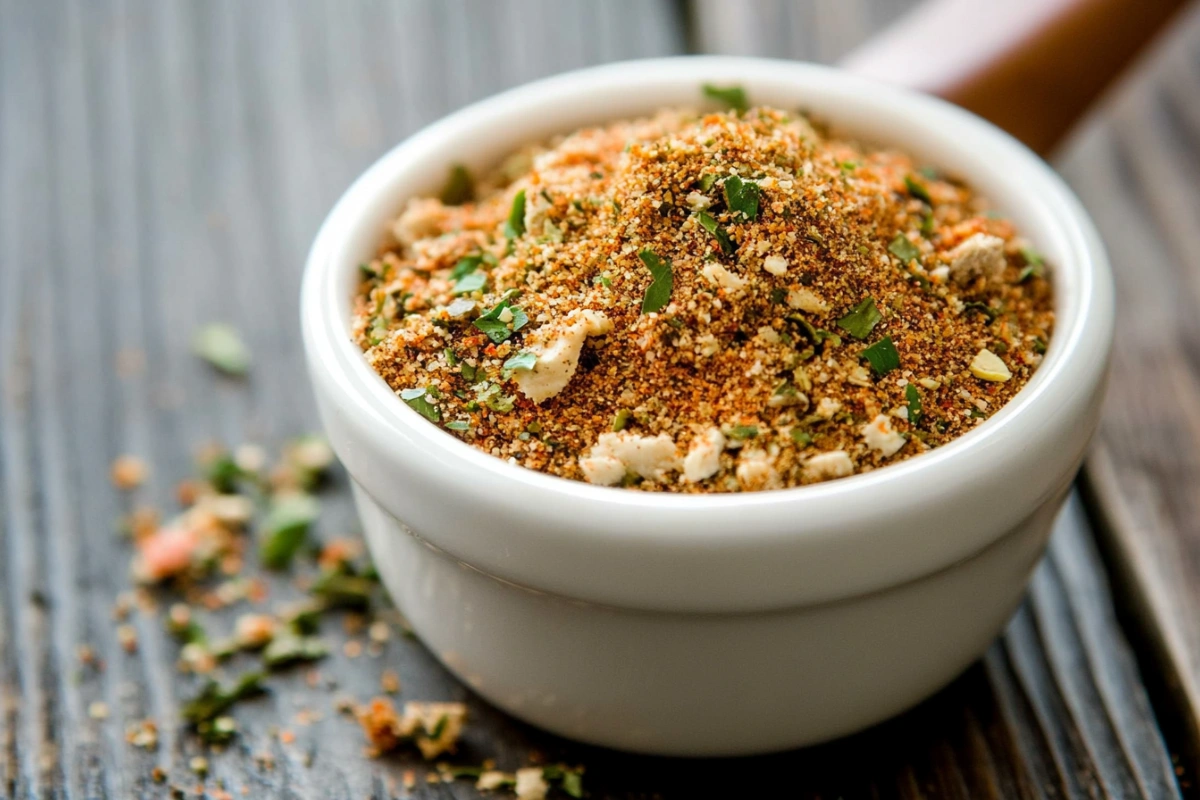Part 1: What is Poultry Seasoning?
Poultry seasoning is a popular spice blend known for its versatility, often used to bring out the flavors in poultry dishes like roast chicken, turkey, or stuffing. If you’ve ever cooked a delicious Thanksgiving dinner or a comforting chicken soup, chances are you’ve encountered poultry seasoning. But what exactly is in it, and how can you use it to elevate your meals? Let’s explore!
At its core, poultry seasoning is a mixture of herbs and spices designed to complement the flavors of poultry. It typically includes herbs like sage, thyme, rosemary, and marjoram, but it may also contain other ingredients like nutmeg or pepper to round out the flavor profile. Together, these ingredients create a blend that enhances the taste of roasted or grilled meats, as well as stuffing and other side dishes.
Whether you’re a seasoned cook or a home chef just starting out, understanding what goes into this seasoning mix is key to unlocking its full potential. You can use poultry seasoning not only for chicken or turkey but also in a variety of other dishes, including soups, stews, and even vegetables. So, let’s take a closer look at the ingredients that make up this flavorful seasoning blend.
What’s in Poultry Seasoning?
The Ingredients That Make Poultry Seasoning
Poultry seasoning is packed with herbs and spices that bring rich, savory flavors to your dishes. While the ingredients can vary slightly depending on the brand or recipe, there are several key components that are almost always included in this essential spice mix.
Sage: The Heart of Poultry Seasoning
The most significant and widely recognized herb in poultry seasoning is sage. Sage’s warm, earthy, and slightly peppery flavor makes it the backbone of this blend. Its rich aroma adds a comforting, savory note to dishes, particularly stuffing, roast turkey, and chicken. If you’ve ever made Thanksgiving dinner, you’ve likely noticed that sage is a key ingredient in the stuffing.
Thyme: A Subtle Earthy Note
Next is thyme, a herb that brings an earthy and subtly minty flavor to poultry seasoning. While thyme is not as bold as sage, it complements other herbs beautifully, offering depth without overpowering the dish. Whether used in a roasted chicken rub or stirred into a savory gravy, thyme plays a supporting role in enhancing the overall flavor profile of the seasoning.
Rosemary: Bold and Aromatic
Another vital ingredient in poultry seasoning is rosemary. Known for its strong, aromatic flavor, rosemary has a slightly piney taste that’s both bold and refreshing. It works well in poultry seasoning, as it pairs nicely with the other herbs, adding a touch of earthiness and freshness. You’ll often find rosemary in Mediterranean and roasted poultry dishes.
Marjoram: Sweet and Mild
Often overshadowed by the stronger flavors of sage and thyme, marjoram plays a subtle role in poultry seasoning. With its sweet, mild, and slightly floral flavor, marjoram softens the more intense spices and creates a well-rounded seasoning blend. Marjoram is similar to oregano, but with a more delicate and sweet profile, making it a perfect match for poultry dishes.
Other Herbs: Nutmeg, Pepper, and More
To complete the seasoning, some blends include a dash of nutmeg or pepper. Nutmeg adds a hint of warmth and a slight sweetness, which works wonders in enhancing the flavor of stuffing or sauces. Meanwhile, pepper provides a mild heat that balances the richness of the poultry.
Together, these herbs create a seasoning blend that’s perfect for poultry but also versatile enough to use in a variety of other recipes. From soups to gravies, poultry seasoning is a pantry staple that elevates any dish it touches.
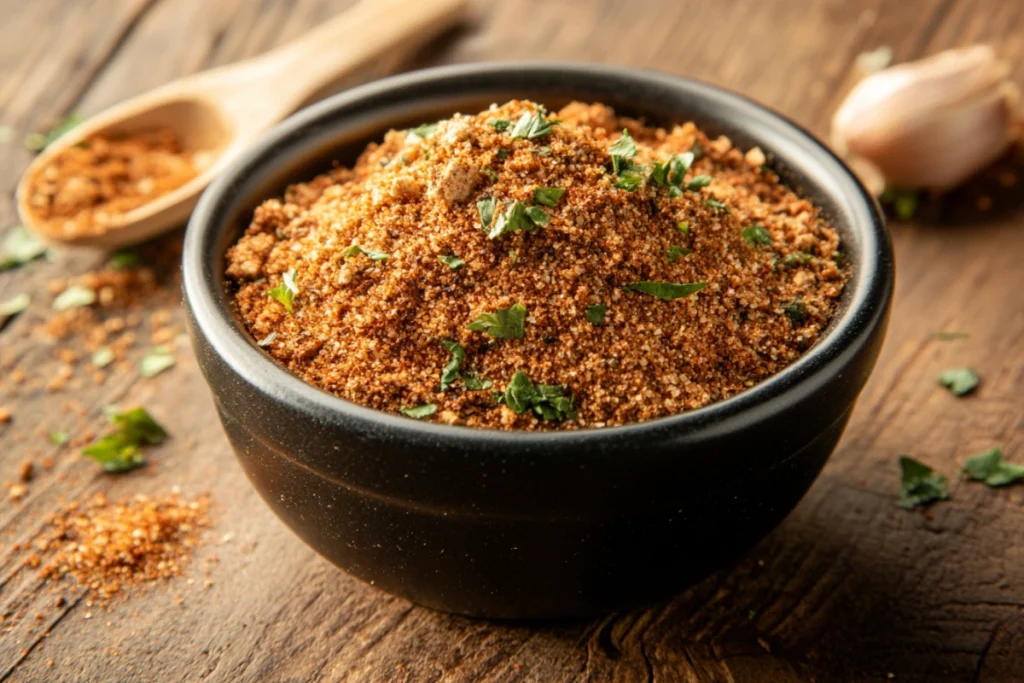
Part 2: Homemade Poultry Seasoning – How to Make Your Own
If you’re a fan of making your own seasonings, creating a homemade poultry seasoning blend is easier than you might think! Not only will you save money, but you’ll also have complete control over the ingredients, allowing you to customize the flavor to your liking. Plus, it’s a fun kitchen project that can make your dishes even more flavorful and fresh.
Why Make Homemade Poultry Seasoning?
While store-bought poultry seasoning is convenient, it often contains additives, preservatives, and extra salt. Making your own version ensures that you can avoid these, using only natural, high-quality ingredients. Additionally, by blending your own spices, you can tweak the ratios of each herb to suit your taste. This means more sage if you love the earthy flavor or a little extra rosemary if you want a bolder, piney note.
Homemade Poultry Seasoning Recipe
To make your own poultry seasoning, you’ll need the following common ingredients, many of which you’ve already seen in store-bought blends. Here’s a simple recipe you can follow:
Ingredients:
- 2 tablespoons dried sage
- 1 tablespoon dried thyme
- 1 tablespoon dried rosemary (crushed for a finer texture)
- 1 tablespoon dried marjoram
- 1/2 teaspoon ground nutmeg (optional)
- 1/2 teaspoon ground black pepper (optional)
Instructions:
- Combine the Ingredients: In a small bowl, measure and mix together all the dried herbs and spices. For a finer blend, you can use a mortar and pestle to crush the rosemary and thyme. This step helps release their oils, making the seasoning more fragrant and flavorful.
- Storage: Once you’ve mixed your ingredients, transfer the poultry seasoning to an airtight container. It’s best to use it within six months to ensure the spices remain fresh and potent.
- Use: Sprinkle your homemade seasoning generously over poultry before roasting, grilling, or baking. It’s also great in gravies, stuffings, or soups. If you’re feeling adventurous, try it on roasted vegetables, or mix it into a marinade for chicken!
Poultry Seasoning Variations
If you like to experiment with flavors, there are countless ways to customize your homemade poultry seasoning. You can add other spices to suit your preferences or dietary needs.
- Garlic powder: Adds depth and savoriness.
- Onion powder: For a sweet, slightly tangy flavor.
- Cayenne pepper or chili flakes: If you like a spicy kick in your poultry seasoning.
- Lemon zest or dried lemon peel: A zesty twist for fresh, bright flavors.
The possibilities are endless, and making your own blend allows you to tailor the seasoning to the exact flavor profile you want for your dishes.
Benefits of Homemade Poultry Seasoning
Creating your own poultry seasoning offers several advantages:
- No preservatives or additives – You’ll be using natural, wholesome ingredients.
- Freshness – Homemade blends tend to be fresher and more aromatic.
- Customization – Adjust the seasonings to your personal taste or dietary restrictions.
- Cost-effective – Buying herbs and spices in bulk and making your own blend can be much cheaper than constantly purchasing premade mixes.
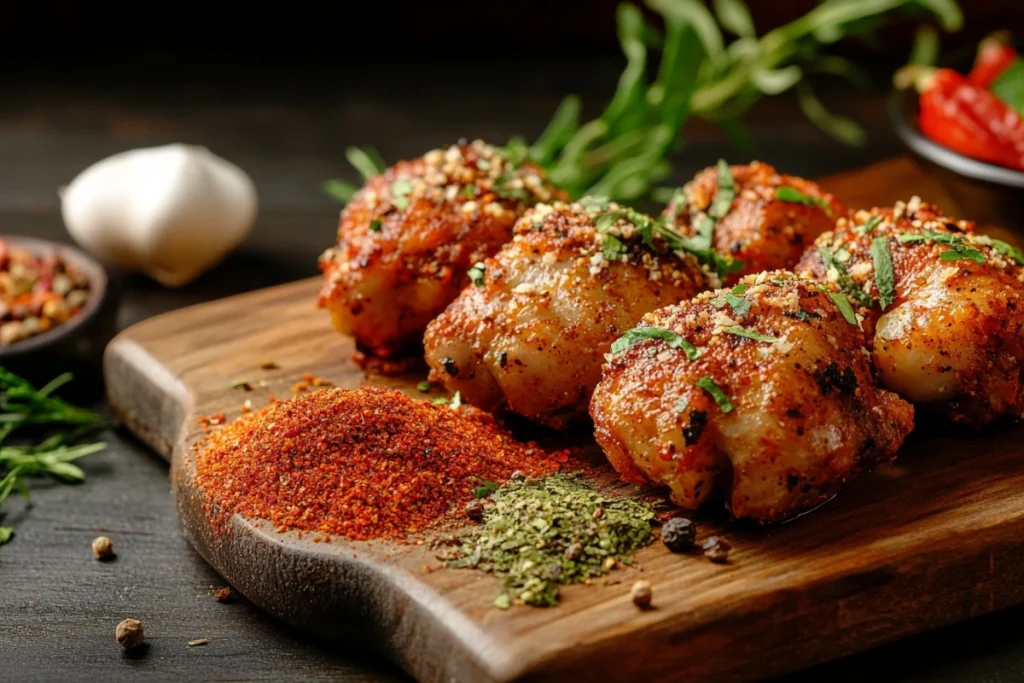
Part 3: How to Use Poultry Seasoning in Your Cooking
Now that you’ve learned how to make your own homemade poultry seasoning, it’s time to get creative in the kitchen. This aromatic spice blend can be used in a variety of dishes, from simple roasted chicken to hearty soups and savory stuffing. Let’s explore some of the best ways to incorporate this versatile seasoning into your meals!
1. Roasted Chicken or Turkey
One of the most popular uses for poultry seasoning is on roasted meats, especially chicken and turkey. This spice blend brings a wonderful depth of flavor, enhancing the natural taste of the poultry without overpowering it. Here’s how you can use it:
- Pre-cooking: Before roasting, rub a generous amount of poultry seasoning all over the chicken or turkey. If you’re making a whole bird, be sure to coat both the skin and the inside cavity for maximum flavor. Adding a little olive oil or melted butter on top will help the seasoning stick and create a crisp, golden skin.
- Inside the Bird: For added flavor, sprinkle some poultry seasoning inside the cavity along with other ingredients like garlic, onions, or lemon wedges. The heat from the roasting process will infuse the herbs into the meat, creating a fragrant and juicy roast.
2. Stuffing or Dressing
If you’re making a stuffing for a turkey or chicken, poultry seasoning is a must-have ingredient. Whether you’re using bread, cornbread, or another base, this seasoning adds a layer of savory depth to the dish. Here’s a simple way to use it in stuffing:
- Add about 1-2 teaspoons of poultry seasoning per 4 cups of bread cubes in your stuffing mix.
- Combine it with other traditional stuffing ingredients like sage, thyme, and rosemary for an extra burst of flavor.
- You can also mix it with butter or broth before stirring it into the stuffing, ensuring every bite is packed with herby goodness.
3. Poultry Seasoning in Soups and Stews
Poultry seasoning can be the secret ingredient in many soups and stews, especially those featuring chicken or turkey. Whether you’re making a classic chicken noodle soup or a creamy chicken pot pie, this seasoning adds warmth and complexity to the broth.
- In Soups: Add a teaspoon of poultry seasoning to your chicken broth to create a savory base. It pairs wonderfully with vegetables like carrots, celery, and potatoes.
- In Stews: For a more robust dish, stir in poultry seasoning during the cooking process of a chicken or turkey stew. It helps enhance the flavors of the meat and vegetables, giving the stew a well-rounded taste.
4. Savory Roasted Vegetables
If you’re preparing roasted vegetables, poultry seasoning is a fantastic way to add some extra flavor. The earthy herbs in the blend complement the natural sweetness of roasted vegetables like carrots, sweet potatoes, and Brussels sprouts.
- Simply toss your vegetables with a little olive oil, salt, pepper, and about 1 teaspoon of poultry seasoning. Roast them in the oven at 400°F (200°C) for 25-30 minutes, stirring halfway through for an even, golden brown roast.
- For an extra twist, you can mix poultry seasoning with a bit of balsamic vinegar or maple syrup before roasting to add a tangy or sweet flavor to the vegetables.
5. Meatballs, Meatloaf, and Burgers
You might not have thought of adding poultry seasoning to meatballs or meatloaf, but this seasoning blend can enhance the flavors of all types of ground meats. Whether you’re using chicken, turkey, or even beef, adding a teaspoon or two of poultry seasoning will elevate your dish.
- Meatballs: Mix poultry seasoning into your ground meat along with breadcrumbs, eggs, and garlic. Shape into balls and bake or fry.
- Meatloaf: Add the seasoning to the ground meat mixture for a flavorful meatloaf that’s perfect for any dinner table.
- Burgers: Incorporate poultry seasoning into the patties for a savory burger with a hint of herbiness. You can also sprinkle a little extra on top just before grilling.
6. Poultry Seasoning in Marinades
A quick marinade with poultry seasoning can infuse your meat with flavor in just a short amount of time. Mix it with olive oil, lemon juice, and a touch of salt and pepper for a simple marinade that works well with chicken, turkey, or even other meats like pork.
- Let your meat marinate for at least 30 minutes (or up to overnight in the fridge) to allow the poultry seasoning to fully permeate the meat.
- Add a bit of honey or brown sugar to the marinade for a sweet and savory flavor combo.
Part 4: Poultry Seasoning Substitutes
While poultry seasoning is a fantastic blend of herbs and spices, there may be times when you don’t have it on hand, or you may simply want to experiment with different flavors in your cooking. Luckily, there are plenty of easy substitutes that can give you similar results. Let’s explore some options that can replace poultry seasoning in various dishes.
1. Sage, Thyme, and Rosemary Combination
If you’re looking for a straightforward substitute, a mix of sage, thyme, and rosemary is an excellent choice. These three herbs are some of the primary ingredients in poultry seasoning and are easy to find in most kitchens.
- Sage provides an earthy, savory flavor that’s key to poultry seasoning.
- Thyme offers a subtle floral flavor that complements the heartiness of sage.
- Rosemary adds a piney, aromatic essence that pairs wonderfully with poultry.
To create a substitute, combine equal parts of sage, thyme, and rosemary. You can adjust the proportions based on your taste preferences. For example, if you love the boldness of sage, use a little more of it, or reduce the rosemary if you prefer a milder flavor.
2. Poultry Seasoning with Garlic Powder and Onion Powder
Another option is to combine poultry seasoning with garlic powder and onion powder. These two pantry staples provide a savory, slightly sweet flavor that complements the herbs in the original blend. This combination is especially useful for making meatballs, meatloaf, or even simple roasted vegetables.
To use this substitute:
- Mix 1 teaspoon of garlic powder and 1 teaspoon of onion powder with 1 teaspoon of poultry seasoning. This blend can easily replace a store-bought poultry seasoning in any recipe.
3. Herbes de Provence
Herbes de Provence is another seasoning blend that works well as a substitute for poultry seasoning. This mix includes many of the same herbs, such as thyme, rosemary, and savory, but also incorporates lavender, which adds a unique floral touch. While this may not be the ideal choice for every dish, it can be a great way to introduce a different flavor profile into your cooking.
To substitute, use the same amount of Herbes de Provence as the recipe calls for in poultry seasoning. Be aware that the lavender in the blend can make it taste a bit sweeter and more aromatic than a typical poultry seasoning.
4. DIY Poultry Seasoning Recipe
If you prefer to make your own seasoning mix from scratch, here’s a simple homemade poultry seasoning recipe you can easily mix at home:
- 2 tablespoons dried sage
- 2 teaspoons dried thyme
- 2 teaspoons dried rosemary
- 1 teaspoon marjoram (optional)
- 1 teaspoon black pepper
Mix all the ingredients together, and you’ll have a flavorful poultry seasoning blend ready to use! This DIY version lets you control the proportions of each herb to better match your personal preferences.
5. Using Poultry Seasoning in Non-Poultry Dishes
While poultry seasoning is designed to complement chicken and turkey, don’t be afraid to use it in other dishes. This seasoning works well in vegetarian meals, particularly when you want to mimic savory, herbaceous flavors in plant-based recipes. Here are a few ideas:
- Vegetarian Stuffing: Add poultry seasoning to a stuffing made with mushrooms or plant-based sausage. This seasoning adds depth and warmth without the meat.
- Vegetable Roasts: Sprinkle some on roasted root vegetables like sweet potatoes, carrots, or parsnips for a savory boost.
- Soups & Stews: Add a pinch to creamy vegetable soups or stews for a comforting herbal flavor.
6. Creating a Low-Sodium Poultry Seasoning Substitute
For those watching their sodium intake, you can create a lower-sodium substitute by simply omitting any salt from your seasoning blend and using only the herbs. A mixture of sage, thyme, rosemary, and marjoram will still provide the classic flavors found in poultry seasoning but with far less sodium.
This option is particularly helpful when you want to reduce sodium without sacrificing the rich taste that poultry seasoning provides.
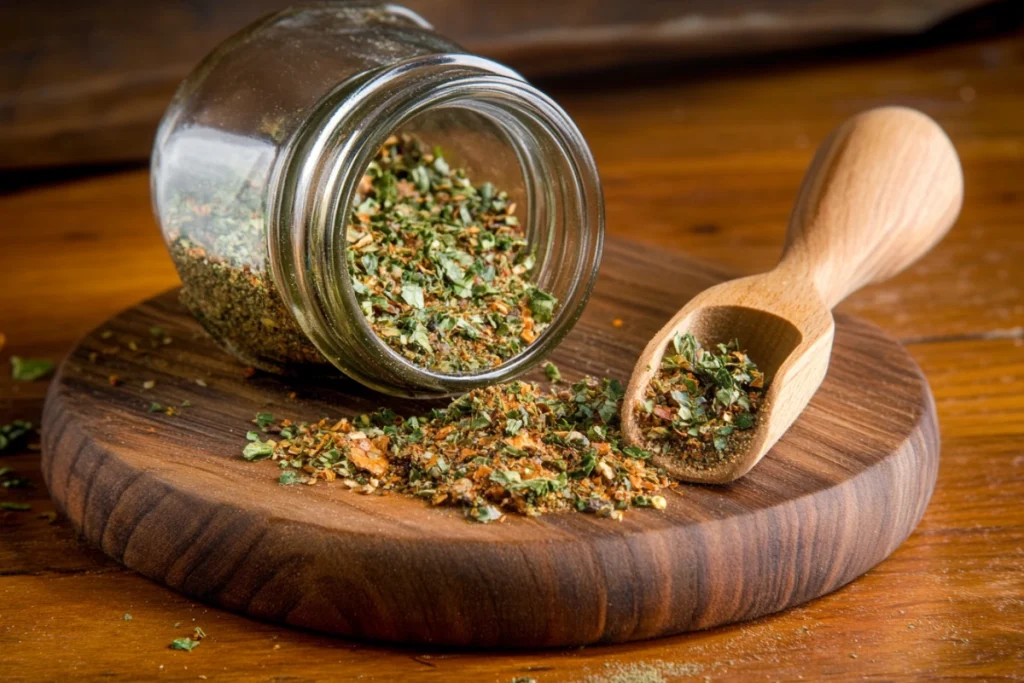
Part 5: Storing and Preserving Poultry Seasoning
Proper storage of your poultry seasoning is essential to maintaining its flavor and potency over time. Like many dried herbs and spices, poultry seasoning can lose its freshness and aroma if not stored correctly. Let’s explore the best ways to preserve your seasoning blend and ensure it remains as flavorful as the day you mixed it.
1. How to Store Poultry Seasoning
To keep your poultry seasoning fresh, store it in a cool, dry place, away from heat and light. A dark cabinet or pantry is perfect for this. You’ll want to avoid placing it near heat sources like stoves or microwaves, as heat can cause the herbs to degrade faster. Here are some tips to keep in mind:
- Airtight Containers: Always use an airtight container to store your poultry seasoning. Glass jars with tight-fitting lids or resealable bags are excellent choices for sealing in freshness.
- Avoid Humidity: Store your seasoning away from areas with high humidity, as moisture can cause herbs to clump or lose their flavor more quickly. A sealed jar or bag will protect it from moisture in the air.
- Labeling: Label your containers with the date you made or purchased the seasoning. This way, you can easily track its age and know when it’s time to replace it.
2. How Long Does Poultry Seasoning Last?
While poultry seasoning doesn’t spoil in the traditional sense, it can lose its potency over time. Most dried herbs have a shelf life of about 1-3 years, depending on the specific herb and storage conditions. For poultry seasoning, the herbs in the blend will gradually lose their essential oils, which are responsible for their flavor and aroma.
- In the Pantry: When stored correctly in an airtight container, your poultry seasoning should stay fresh for up to 1-3 years. After this period, the seasoning may still be safe to use, but its flavor will not be as strong.
- Check for Freshness: Before using older seasoning, check its aroma. If it doesn’t smell as fragrant or has lost some of its vibrancy, it might be time to replace it.
3. Signs Your Poultry Seasoning Has Gone Bad
As poultry seasoning ages, it loses its potency, but it doesn’t necessarily “go bad” in the way perishable foods do. That said, there are a few signs to look out for when determining if your seasoning is no longer usable:
- Loss of Aroma: If the seasoning no longer has a strong smell, this is a clear sign that its oils have dissipated. Without this fragrance, the blend will lack flavor in your dishes.
- Color Change: Dried herbs tend to lose their bright color as they age. If your poultry seasoning has turned dull or brownish, it may not be as flavorful as it once was.
- Texture Changes: If your poultry seasoning feels clumpy or overly dry, it could mean that moisture has gotten in. While not harmful, this could affect its texture and flavor.
4. Can You Freeze Poultry Seasoning?
While freezing can help extend the life of certain foods, it’s not the best option for poultry seasoning. Freezing may cause the herbs to lose their delicate oils and degrade their flavor. The fluctuating temperatures of a freezer can also cause condensation, which can affect the seasoning’s texture. It’s better to store your seasoning in a cool, dry place rather than freezing it.
5. How to Revive Old Poultry Seasoning
If you find that your poultry seasoning has lost some of its fragrance or flavor, there are a couple of ways you can breathe new life into it:
- Grind the Herbs: If your seasoning contains whole dried herbs (like rosemary or sage), consider grinding them up in a spice grinder or mortar and pestle. This will release more oils and enhance the flavor.
- Add Fresh Herbs: If your blend is still fairly fresh but lacking depth, adding a small amount of fresh herbs can boost the flavor. Add a little more thyme, sage, or rosemary, depending on the dominant herbs in your seasoning.
Part 6: Creative Ways to Use Poultry Seasoning in Your Cooking
Poultry seasoning isn’t just for seasoning poultry. In fact, this versatile blend can be used in a wide variety of dishes, from savory sides to even desserts! If you’re wondering how to get the most out of your poultry seasoning, let’s dive into some exciting ways to incorporate it into your meals.
1. Season Your Vegetables
While poultry seasoning is often associated with chicken or turkey, it can work wonders with roasted or sautéed vegetables. The blend of thyme, sage, rosemary, and marjoram brings out the natural sweetness of vegetables, adding depth and complexity to simple dishes.
- Roasted Vegetables: Toss carrots, potatoes, or Brussels sprouts in olive oil and poultry seasoning, then roast them until tender. The seasoning will enhance their flavor, making them a savory side dish.
- Sautéed Greens: Add poultry seasoning to sautéed spinach, kale, or collard greens for an earthy and aromatic flavor. A pinch of salt and pepper can further elevate the taste.
2. Add to Stuffing and Dressings
If you’re preparing stuffing for a holiday meal or just a comforting dinner, poultry seasoning is the perfect addition. The blend’s herbs complement the bread or cornbread base of stuffing, infusing it with warm, savory flavors.
- Classic Stuffing: Mix poultry seasoning with onions, celery, and broth to create a rich, flavorful stuffing for your roast chicken or turkey. The seasoning works well with any type of bread.
- Vegetarian Stuffing: Even if you’re not using meat, poultry seasoning can make a vegetarian stuffing taste just as hearty and comforting.
3. Elevate Your Soups and Stews
Another fantastic use of poultry seasoning is in soups and stews. The herbs in this blend are ideal for slow-cooked dishes where they can steep and release their full flavors. Whether you’re making a chicken soup, vegetable stew, or even a creamy chowder, a little poultry seasoning will enrich the broth and balance the flavors.
- Chicken Soup: Add a tablespoon or two of poultry seasoning to your chicken soup for an extra layer of flavor. You’ll be amazed at how it enhances the savory notes of the chicken and vegetables.
- Hearty Stews: Whether you’re making beef stew or a plant-based version, adding poultry seasoning will give the broth a rich, herbaceous taste. It’s a great way to deepen the flavor profile without adding too many ingredients.
4. Spice Up Your Gravy
If you’re making gravy to go along with your turkey or roast chicken, consider adding a pinch of poultry seasoning to your gravy mix. The herbs will infuse the sauce with subtle, aromatic flavors that pair perfectly with meats, mashed potatoes, and other sides.
- Homemade Gravy: After roasting your chicken or turkey, deglaze the pan with some broth, and stir in a little poultry seasoning for a flavorful base. Then, thicken with cornstarch or flour, and you’ve got a savory gravy that’s packed with flavor.
5. Use in Marinades and Rubs
Marinades and rubs are an easy way to flavor meat before cooking, and poultry seasoning works wonderfully as a base for both. The combination of thyme, sage, rosemary, and other herbs makes it ideal for seasoning meats before grilling, roasting, or frying.
- Chicken Marinade: Mix poultry seasoning with olive oil, garlic, lemon juice, and a touch of salt to create a simple marinade for chicken. Let it sit for an hour or two before cooking, and you’ll have a juicy, flavorful meal.
- Turkey Rub: Before roasting a turkey, rub the bird with poultry seasoning, olive oil, and a bit of salt. This will enhance the flavor of the meat and give it a delicious golden skin.
6. In Bread and Biscuits
For a twist on traditional bread or biscuit recipes, add a little poultry seasoning into the dough. The herbs will infuse the bread with a subtle, savory flavor that’s perfect for accompanying a meat dish or serving alongside soups and stews.
- Herbed Biscuits: Add a teaspoon of poultry seasoning to your biscuit dough for a savory touch that will complement any meal.
- Savory Cornbread: Mixing poultry seasoning into cornbread batter gives it a warm, herby flavor that pairs wonderfully with chili or a roast dinner.
7. In Breakfast Dishes
While poultry seasoning may not be the first thing that comes to mind for breakfast, it can be a great addition to eggs, breakfast potatoes, and even savory pancakes.
- Scrambled Eggs: Add a dash of poultry seasoning to scrambled eggs for a burst of flavor. Pair it with fresh herbs or cheese for a more indulgent breakfast.
- Savory Pancakes: Try adding poultry seasoning to savory pancakes or waffles. Top them with a dollop of sour cream, smoked salmon, or even some grilled chicken for a unique breakfast or brunch.
8. Make a Poultry Seasoning Paste
If you prefer a more intense burst of flavor, create a poultry seasoning paste by mixing the blend with olive oil or softened butter. Use this paste to coat your meats before cooking for a flavorful crust, or even spread it on vegetables for added flavor.
- Poultry Seasoning Butter: Combine poultry seasoning with softened butter and rub it under the skin of chicken or turkey. This will infuse the meat with a burst of herbal flavor as it roasts.
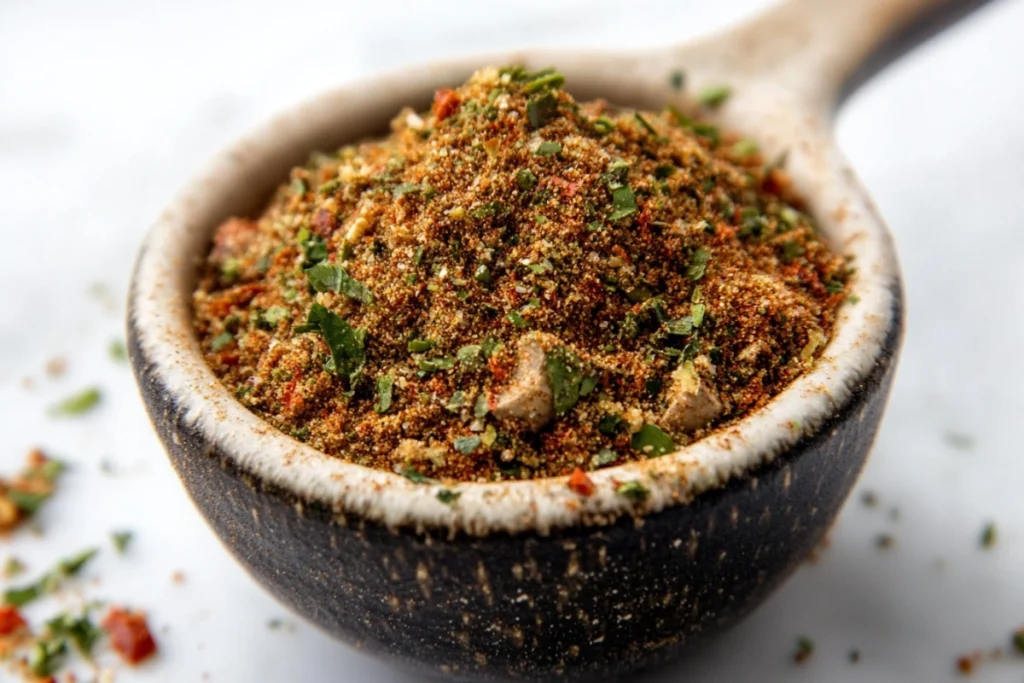
Part 7: Best Poultry Seasoning Substitutes
While poultry seasoning is a favorite for seasoning meat, there are times when you might find yourself out of this seasoning blend or simply want to try something new. Fortunately, there are plenty of poultry seasoning substitutes you can use, all of which bring their own unique flavors to the dish. Whether you’re in need of a quick fix or want to explore a new flavor profile, here are some excellent alternatives.
1. DIY Poultry Seasoning Blend
If you have a well-stocked spice cabinet, you can easily create your own version of poultry seasoning. This homemade blend often contains the same key herbs found in the store-bought variety, but you can tweak it to match your tastes.
- Basic Poultry Seasoning Recipe: Mix together equal parts of thyme, sage, and rosemary, then add a pinch of marjoram, parsley, and a dash of nutmeg for an authentic poultry seasoning flavor. You can even include a bit of salt and pepper for an added boost.
- Customize Your Blend: Feel free to adjust the ratios based on your flavor preferences. For example, if you like a bolder flavor, add more rosemary or sage.
2. Thyme, Sage, and Rosemary
If you don’t have the full range of herbs needed for poultry seasoning, the three main ingredients—thyme, sage, and rosemary—can work well on their own. These herbs are often the foundation of the seasoning blend, so using them individually can still give your dish the flavor you’re craving.
- Perfect for Roasting: If you’re roasting a chicken or turkey, just sprinkle thyme, sage, and rosemary directly on the bird, and it will mimic the depth of flavor found in poultry seasoning.
3. Herbes de Provence
Herbes de Provence is a blend of herbs that is similar to poultry seasoning but with a more pronounced French flair. It typically contains thyme, rosemary, oregano, and sometimes lavender, fennel, or basil. This mixture can be used as a direct substitute for poultry seasoning, bringing a different but equally delicious flavor to your dishes.
- Great for Chicken or Turkey: Just like poultry seasoning, Herbes de Provence is a versatile seasoning that works perfectly with roasted meats, soups, and stews.
- Subtle Sweetness: If your recipe calls for a slightly sweet and floral touch, Herbes de Provence is a great option, though it may be a bit more aromatic than traditional poultry seasoning.
4. Italian Seasoning
Another easy-to-find substitute is Italian seasoning, which contains herbs like oregano, basil, thyme, and marjoram. While it doesn’t exactly replicate the flavors of poultry seasoning, it can still be a great option when you’re in a pinch.
- Versatile Alternative: Italian seasoning works well in chicken dishes, soups, and stews, though it may not provide the exact flavor profile you’re used to. It’s a great option if you want a slightly different flavor but still want that herby boost.
5. Allspice and Nutmeg
If you love the poultry seasoning’s hint of warmth, you might want to use a pinch of allspice or nutmeg. These spices provide the sweet, aromatic flavors that are often present in the seasoning blend.
- For Added Warmth: Nutmeg and allspice are especially great for dishes like stuffing or gravies, where a dash of sweetness complements the savory flavors of the meat.
6. Cajun Seasoning
For a bit of heat and an extra layer of flavor, Cajun seasoning can step in as a substitute for poultry seasoning. While it’s spicier than the typical poultry seasoning, it can be a delicious way to give your chicken or turkey an extra kick.
- Spicy Poultry Seasoning Alternative: If you enjoy bold, spicy flavors, Cajun seasoning can work wonders. Use it in rubs or marinades, but be mindful of the heat—it’s spicier than traditional poultry seasoning.
7. Chicken Bouillon Powder or Granules
In a pinch, you can use chicken bouillon powder or granules as a substitute for poultry seasoning. Though it won’t replicate the exact herbal flavor, it provides a rich, savory taste that can mimic the effect of poultry seasoning, especially in gravies, soups, and sauces.
- Perfect for Broths: If you’re making a chicken broth or soup, using chicken bouillon in place of poultry seasoning will provide that essential savory depth.
8. Celery Salt and Pepper
When you’re looking for a simple and light alternative, celery salt combined with black pepper can serve as a seasoning option. While it won’t bring all of the herbal qualities of poultry seasoning, it does provide a mild, savory touch that’s perfect for lighter chicken dishes.
- Delicate Seasoning for Chicken: Celery salt gives chicken a clean, herby flavor without overpowering the dish. It’s a great choice if you want a subtler seasoning.
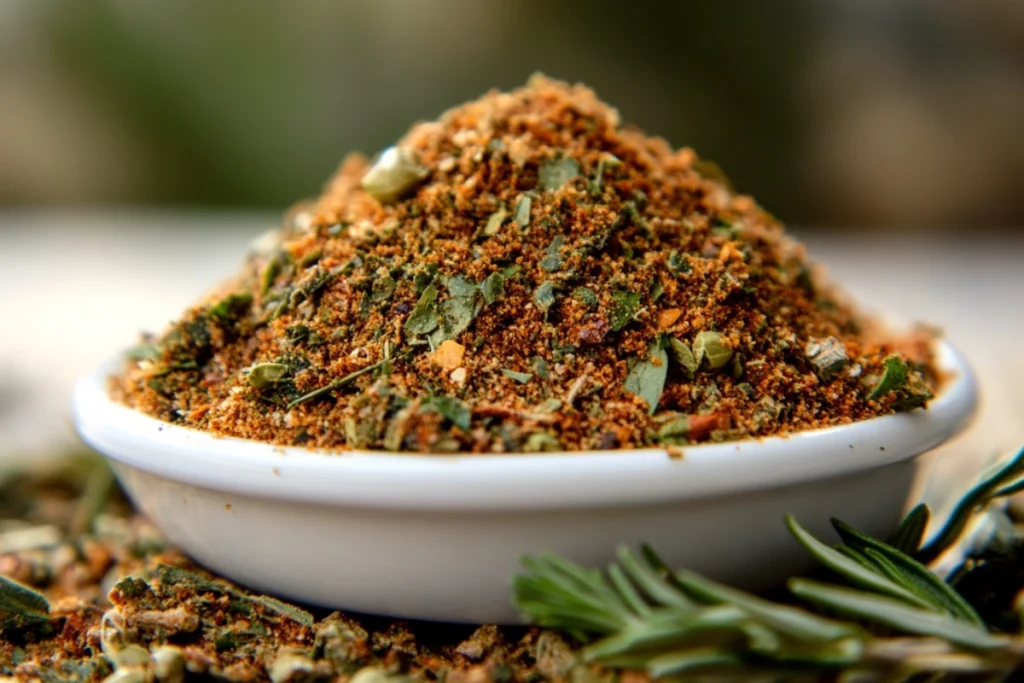
Part 8: FAQs About Poultry Seasoning
When it comes to cooking, poultry seasoning can spark quite a few questions. Here are some of the most frequently asked questions to help clear things up.
1. What is the difference between poultry seasoning and sage?
Sage is actually one of the main ingredients in poultry seasoning, but they’re not the same thing. While sage is a single herb with a strong, earthy flavor, poultry seasoning is a blend of several herbs, including sage, thyme, rosemary, marjoram, and sometimes nutmeg or pepper. The difference lies in the complexity of flavor; poultry seasoning combines multiple herbs to create a rounded, aromatic profile, while sage on its own is more concentrated.
2. Can I use poultry seasoning in soups and stews?
Yes! Poultry seasoning is extremely versatile and can enhance soups, stews, and gravies, especially those made with chicken or turkey. It’s perfect for adding a warm, savory depth to the dish. If you’re looking for a quick fix, poultry seasoning can be a great way to infuse flavor without having to chop fresh herbs.
3. Can I use poultry seasoning for fish or beef dishes?
While poultry seasoning is specifically designed to complement chicken, turkey, and other poultry dishes, it can also be used sparingly in fish or beef recipes. However, the flavor might not always be the best match. If you’re experimenting, try a small amount first and adjust based on your taste preferences. For beef, consider using seasonings like thyme, rosemary, or garlic, and for fish, try dill, tarragon, or lemon zest.
4. How do I make homemade poultry seasoning?
Making your own poultry seasoning is simple and allows you to customize the flavors. A basic recipe includes:
- 1 tbsp thyme
- 1 tbsp sage
- 1 tsp rosemary
- 1 tsp marjoram
- A pinch of nutmeg or pepper (optional)
Combine the herbs and store them in an airtight container. You can also adjust the ratios based on your preferences—some people prefer more sage or rosemary for a stronger flavor.
5. Can I use poultry seasoning for turkey stuffing?
Absolutely! Poultry seasoning is a classic choice for turkey stuffing. It adds a savory, aromatic flavor that pairs perfectly with bread, sausage, or even rice-based stuffing. You can sprinkle it directly into your stuffing mixture for an authentic taste. If you’re making a turkey, you can also rub the seasoning onto the bird before roasting.
6. What is a good substitute for poultry seasoning?
If you find yourself out of poultry seasoning, don’t panic! You can use individual herbs like thyme, rosemary, sage, or marjoram to create your own blend. Or, if you’re in a hurry, Herbes de Provence or even Italian seasoning can work in a pinch. These herbs won’t exactly replicate the flavor of poultry seasoning, but they can provide a similar herby depth to your dish.
7. How should I store poultry seasoning?
To preserve the freshness and flavor of poultry seasoning, store it in an airtight container in a cool, dark place, away from direct sunlight and heat sources. This will help maintain its potency for several months. For maximum freshness, it’s best to use your seasoning within six months.
8. Is poultry seasoning gluten-free?
Most store-bought poultry seasoning blends are naturally gluten-free since they only contain dried herbs and spices. However, always check the packaging to ensure that no gluten-containing ingredients have been added, especially in pre-mixed versions. If you’re making your own seasoning at home, there’s no need to worry about gluten.
9. Does poultry seasoning have salt in it?
Generally, poultry seasoning does not contain salt, but some pre-packaged versions might. If you’re using a store-bought mix, it’s important to check the ingredients for salt or sodium. When making your own blend, you have the option to control how much salt you include, so feel free to skip it or add it to taste.
Conclusion
Poultry seasoning is a flavorful and versatile blend that can elevate your cooking to new heights. Whether you’re using it in a classic roast chicken, adding depth to soups and stews, or preparing a homemade stuffing, this seasoning brings a delightful herbaceous note that complements poultry and beyond. The beauty of poultry seasoning lies not just in its traditional uses, but in its ability to adapt and enhance various dishes with minimal effort.
As we’ve seen, it’s simple to make your own homemade poultry seasoning or to find a poultry seasoning substitute if you’re out of the pre-made blend. With a few basic ingredients like sage, thyme, rosemary, and marjoram, you can create your own signature blend that suits your personal taste. And if you’re ever in doubt about what to use poultry seasoning for, rest assured that this all-purpose seasoning is your go-to solution for adding a touch of warmth and richness to a wide range of meals.
Whether you’re new to cooking or a seasoned pro, keeping a jar of poultry seasoning on hand will always be a wise choice. Not only does it add flavor to your meals, but it also opens up endless possibilities for creativity in the kitchen. Happy cooking!

